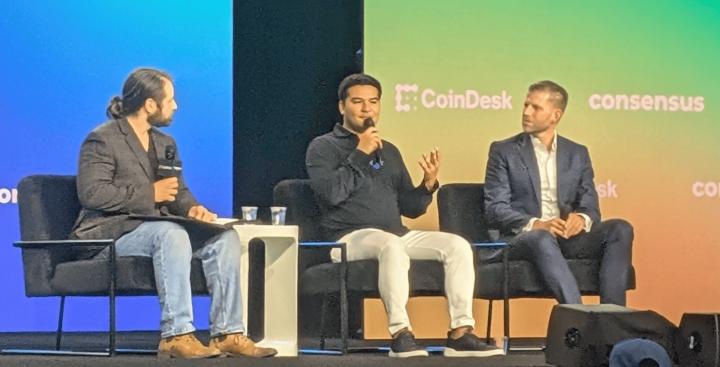Original Title: 《Can Pectra, UX and Team Shuffle Revive ETH?》
Compiled & Translated by: Patti, ChainCatcher
"One of Bitcoin's most outstanding qualities is its protocol design, which is so ingeniously simple," said Vitalik Buterin, the founder of Ethereum, the second-largest cryptocurrency, when discussing the top cryptocurrency Bitcoin.
This statement comes at a time that coincides with the identity crisis Ethereum is currently facing.
A week ago, Vitalik wrote this sentence in his blog post "Simplifying the L1". Three days later, Ethereum developers deployed the most complex upgrade to the blockchain to date.
On one hand, after the Pectra upgrade on Wednesday, ETH achieved its strongest weekly performance since 2021. On the other hand, its co-founder hopes to rebuild the network with a simpler architecture.
Is this the beginning of Ethereum's revival, or just another false dawn for a network that has been stagnant for years while its competitors continue to reach new heights?
In this article, we will explore the changes happening in Ethereum, why these changes are important, and whether these rapid developments can help Ethereum break free from its long-standing doldrums.
Pectra Upgrade: A Key Battle in Ethereum's Revival Attempt
The success of Ethereum's revival attempt largely depends on its recent upgrade.
On May 7, 2024, the Pectra upgrade - the most extensive code change since The Merge (September 2022) - was officially launched. This upgrade made wallets smarter, validators more efficient, and Layer 2 fees lower.
This upgrade took over a month longer than originally planned and changed how Ethereum operates. At its core, the Ethereum Improvement Proposal (EIP)-7702 granted smart contract functionality to ordinary wallets.
This seemingly technical change actually reshaped the basic user experience.
Binji, an anonymous Optimism contributor, wrote on X: "Ethereum now finally feels like a modern network." He added that the Pectra upgrade reduced the number of clicks users need to complete their desired actions.
Simply put, this upgrade brought the following conveniences to users:
- Users can now bundle multiple operations together without approving each transaction step individually.
- Users can pay fees with stablecoins instead of using Ethereum (ETH) for each transaction.
Dapps can even pay gas fees for users, implementing a "freemium" model where users don't need to hold any ETH to interact with them.
For validators, EIP-7251 significantly raised the staking cap from 32 ETH to 2048 ETH. This means lower operating costs, which is especially beneficial for institutional stakers.
Layer 2 also benefited.
EIP-7691 doubled the blob space per block, helping to keep Layer 2 transaction fees low during increased demand. This upgrade comes at the right time - Coinbase's Base Chain developer Jesse Pollak previously warned that Layer 2 demand would grow "10 to 20 times" by 2025.
But can these technical improvements translate into market confidence?
Historically, Ethereum upgrades often came with a "sell the news" effect. After the 2022 "Merge" upgrade, ETH price dropped by over 30%.

@TradingView
However, this time might be different, as the code changes are accompanied by a shift in narrative and leadership.
The result? Within 40 hours of the Pectra upgrade launch, ETH price surged by about 40%.

@TradingView
Vitalik Calls for Reshaping Ethereum User Experience
Three days before the Pectra upgrade officially launched, Vitalik Buterin published what might be his most important vision statement in years - "Simplifying the L1".
His core message was that Ethereum must become "close to as simple as Bitcoin" within five years.
Over the years, Ethereum has continuously increased its complexity to address various technical challenges. Now, the Ethereum co-founder hopes to remove this complexity to ensure the network's long-term sustainability and resilience.
In his vision statement, he noted that even high school students can understand Bitcoin's code. In contrast, Ethereum has become increasingly complex, limiting the range of people who can effectively contribute to it.
Vitalik's plan includes three radical proposals:
- Replace the Ethereum Virtual Machine (EVM) with RISC-V architecture. The RISC-V architecture is simpler and more efficient, promising a "hundredfold performance improvement".
- Simplify Ethereum's consensus mechanism through "3-Slot-Finality", abandoning complex systems like epochs and validator shuffling.
- Standardize the entire protocol stack, from data encoding to tree structures.
Ethereum Foundation Leadership Reorganization
In February this year, Ethereum Foundation Executive Director Aya Miyaguchi announced her transition to a newly created "Chairman" role, drawing a line under months of community dissatisfaction with the foundation's leadership and direction.
Previously, critics increasingly questioned the foundation's approach - whether prioritizing ideological purity over competitiveness in an increasingly competitive market environment could meet Ethereum's development needs.
The resulting reorganization was officially finalized in late April, marking a significant governance transformation in Ethereum Foundation's history.

@Ethereum
The foundation's new leadership quickly clarified their focus: expanding mainnet capacity, improving Layer 2 rollups, and enhancing user experience.
The two co-directors wrote in an open statement: "We are well aware that we need to accelerate the journey for developers, founders, and institutions developing and adopting Ethereum technology."
For years, the foundation maintained what critics called a "neutral" stance towards ecosystem development, avoiding any activities that seemed like marketing or competitive positioning.
The new co-director Stańczak stated in a Bankless interview that improving communication is now a priority for the foundation, and that "clearly communicating is part of marketing".
This simple statement represents a dramatic shift from the foundation's previous attitude of not even acknowledging marketing as a legitimate function.
Challenges Remain
Despite these promising developments, Ethereum still faces enormous resistance.
Currently, Ethereum's ETH is trading at around $2,200, less than half of its all-time high of $4,878 in November 2021. While Bitcoin and Solana have already broken their previous records in 2025, Ethereum remains stagnant.

@TradingView
In March this year, affected by market volatility from Trump's tariff policies, ETH fell more than other major cryptocurrencies, briefly dropping below $1,600 - its lowest point in a year and a half.
Critics point out fundamental problems with Ethereum's economic model.
Layer 2 Paradox: Layer 2's success means reduced transactions on the mainnet, consequently lowering ETH's fee income.
Low Staking Efficiency: Before the Pectra upgrade, staking rules forced institutional stakers to operate multiple validator nodes, increasing costs and reducing returns.
Technical Debt Accumulation: Ethereum's complexity has slowed down innovation and raised the threshold for contributing.
Moreover, competition is becoming increasingly fierce.
In February and April this year, Solana's DEX trading volume exceeded Ethereum's. Even in the institutional investment field, Bitcoin ETFs captured most of the investment inflows, while Ethereum-related products received a relatively cold market reception.
The leadership crisis in March further exacerbated these issues.
Against this background, it is not difficult to understand why the Ethereum Foundation, Vitalik, and core developers are now actively taking action from multiple aspects. After all, maintaining the status quo is no longer sustainable.
So, can these changes reverse the challenges accumulated by Ethereum over the years?
Ethereum Transformation Calibration
Ethereum's current transformation is not limited to individual upgrade initiatives, but rather a recalibration of its overall development path.
With the advancement of this series of changes, Ethereum finally realizes that excellent technical capabilities alone are not sufficient to maintain a long-term foothold in the cryptocurrency world.
The key lies in the timing of the transformation. These changes come too late after years of market share loss and poor price performance. After the Pectra upgrade, ETH price surged by 40%, indicating that investors still have strong interest in Ethereum. However, Ethereum faces a tough competition from projects that have integrated simplicity into their design from the beginning, rather than retrofitting later.
The Ethereum Foundation bringing technical experts into management positions and acknowledging the importance of marketing shows that it has begun to address the cultural inertia that hinders its competitiveness.
The improvements in the validator economic model and Layer 2 scaling achieved by the Pectra upgrade will bring positive benefits in the short term. From a long-term perspective, whether Vitalik's five-year RISC-V architecture vision can maintain sustained focus will be a major challenge for Ethereum. After all, Ethereum has often struggled to maintain focus due to conflicting priority tasks in its past development.
The upcoming next upgrade - Fusaka - will be a key indicator of Ethereum's strategic transformation. If this upgrade places mainnet improvements on top of Layer 2 network infrastructure, it will confirm that Ethereum's strategic shift is genuine and enduring, rather than a temporary measure.
The next 12 months will reveal whether these changes are Ethereum's revival or merely a slow adaptation to market realities. For investors, Ethereum's ability to steadfastly pursue its new direction can be glimpsed from the continued effectiveness of its leadership and the momentum of development progress, which is far more important than any single technical milestone.
If Ethereum can complete this transformation while adhering to its core values, its "world ledger" vision may reposition ETH as a cornerstone asset of the next-generation global financial system, with a value far exceeding its current price of $2,200.








